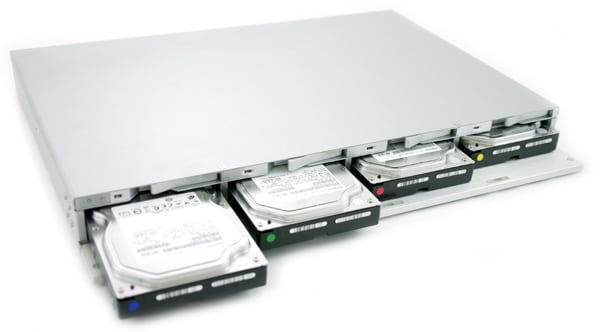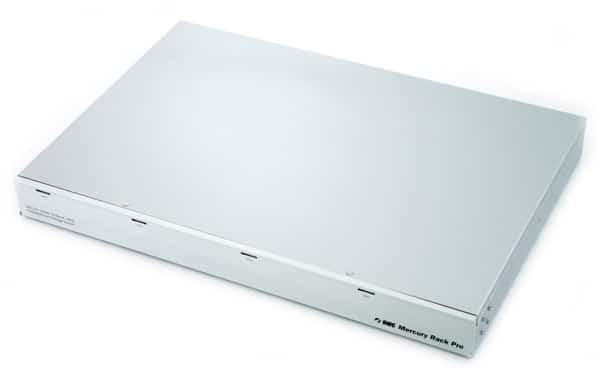Serious audio and video production requires serious storage space. Uncompressed HD video consumes 190MB of drive space per second. That can drop as low as 1.5MB/s with compression, but there’s truth in the video editor’s lament that no matter how much storage space you have, you always need more. OWC hopes to help resolve this issue with the Mercury Rack Pro, which offers up to 12TB of storage in a slim 1U body that is ready for the rack or can be converted for desktop duty.
Compounding the digital asset storage problem is the trend to tapeless digital acquisition. Tapes that came out of cameras were once considered both the master source material and ultimate backup. Only a subset of the footage would be ingested into the editing workstation, and usually only the final output would be stored digitally for any length of time. Detailed logs of what footage was ingested and then used were kept. Called “Edit Decision Lists,” or EDLs, these logs could be used to locate specific footage on the master tape if the need ever arose.
Tapeless editing has changed that. There’s not a physical master copy anymore, just the first digital file written by the camera to some form of flash memory. It has to be stored somewhere, but as cheap as flash memory has become it’s still not as cost-effective for long term storage as tapes once were. Professional editors are loathe to delete anything because clients tend to come back months, even years later, expecting raw footage to still exist. Large production houses have invested in SAN solutions for long term storage, but smaller operations have to rely on large disk arrays attached to individual workstations.
As if all that weren’t enough, audio and video editing workstations must be able to work with footage in real time. This requires storage solutions to have the ability to maintain sustained high-speed reads and writes. Complicating this even more is the current trend among non-linear video editors to render effects like image stabilization, motion tracking and transitions in the background while other editing tasks are being performed. All of these factors combine to require storage media that are extremely fast, reliable and spacious.

The Mercury Rack Pro is billed as a professional-grade hardware RAID device for audio and video production filling that niche. It’s a 1U rack-mountable enclosure (convertible to use outside of the rack as well) with four SATA 6Gb/s drive bays and a custom JMICRON chipset-based controller capable of handling up to 12GB of space. It supports RAID 0, 1, 5, and 10 as well as a volume spanning mode that combines unlike drive sizes into a single volume. It can also serve as a JBOD enclosure. The enclosure supports multiple interfaces including FireWire 800 and 400, USB 3.0 and eSATA.
The enclosure is pre-populated with four drives in capacities of 500GB, 1TB, 1.5TB, 2TB or 3TB, which give the enclosure maximum capacities of 2TB, 4TB, 6TB, 8TB and 12TB respectively. Of course, the real-world usable capacity will depend entirely on how the drives are configured. By default, the unit ships configured for RAID 5 which reduces the usable space by the capacity of one component drive. It also ships formatted as Mac OS Extended, a nod, perhaps, to OWC’s long history of supplying Mac upgrade components. Windows or Linux users will need to re-partition the unit to make it usable.
The company describes the drives as “desktop class or entry-level server hard drives […] not specifically engineered for 24/7 use in a server environment.” As of this writing, the published specifications list a combination of Hitachi Deskstar 7K1000.C and 7K3000 drives and Hitachi UltraStar A7K2000 or 7K3000 drives depending on the model. OWC reserves the right to substitute hard drives based on availability; so the drives on the unit you get may not be identical to the ones listed on the web site.
Design and Build
The Rack Pro fits in a single rack unit, so the width (19-inches) and height (1.7-inches) are standard. It’s 18-inches deep, which means side rails are necessary to rack mount the unit and they aren’t included. The case has a silver brushed metal finish that, overall, gives the unit the impression of a large metal pizza box – though a bit more rigid than the cardboard comparison. The bottom of the unit is tapped to accept screws used to mount rubber feet so it can be used on a desktop. The left and right sides have four screw holes for rack pulls and two additional holes for attaching rails.

The front of the enclosure consists of a door hinged on the bottom. There are four lenses mounted in the door to transmit the light from the multicolored drive status LEDs mounted in the main chassis over each drive bay. Under normal operation this door would be shut, but if an LED indicates a faulty drive it can be opened to reveal the drives themselves. The combination power and alarm set/mute button is located on the left. Each of the four drive bays accept 3.5″ drives and have a drive release lever mounted above it. The drives themselves require no trays to be installed.

The back of the enclosure features a standard grounded power connector and a switch to select between 115V and 230V AC. Three 40mm fans provide internal ventilation. The set of interfaces is set slightly off-center and to the right of two of the fans. There is one eSATA, USB 3.0 and FireWire 400 port, while there are two FireWire 800 ports to allow for daisy-chaining. There are three DIP switches to the right of the FireWire 800 ports used to set the enclosure’s configuration of the drive. The switch positions for various the RAID, Span, and JBOD settings are stenciled above the switches. Experienced users will know not to change the settings of these switches and the manual clearly describes the implications of doing so, but it would be nice if these switches weren’t so benign in appearance.
In Use
As mentioned above, the back of the Mercury Rack Pro has a number of DIP switches for setting the RAID scheme that best suits your needs. One advantage of the on-board JMicron chipset is that it is very easy to setup and initialize each RAID mode with no more than a few button presses. Once the new RAID mode is set the system performs a few drive checks and in a few seconds you are completely ready to go in the newly selected mode.

If you are looking for the best speed and highest capacity, you can go with RAID0, although if you don’t mind losing a bit of space for the sake of some data security RAID5 is the way to go. We benchmarked the Mercury Rack Pro in both RAID5 and RAID0 modes using eSATA to show the best case scenarios for transfer speeds. The good news is no matter which mode you decide to go with, each will be close to fully saturating eSATA with sequential file transfers.
To measure the transfer speeds of both RAID0 and our RAID5 configuration across the four 500GB 7,200RPM Hitachi hard drives supplied inside the unit. Straight-line performance in both modes came out very close in our 2MB sequential file transfer test. We measured 264MB/s read and 225MB/s write in RAID0 and 257MB/s read and 228MB/s write in RAID5. RAID0 turned out to have a slight edge in read speed, with RAID5 edging out on write speed… although both were extremely close.
Switching to our 2MB random transfer test, some of the differences between RAID0 and RAID5 started to become more evident. Both modes measured 68MB/s read, but RAID0 won out with 50.5MB/s write while RAID5 topped at just 33.5MB/s. This same trend was also spotted in the smaller 4K random transfer test as well. We measured 0.18MB/s read on both RAID modes, but RAID0 offered a faster 0.49MB/s write with RAID5 measuring just 0.09MB/s. If you are working with a lot of small files and constantly writing to the storage unit, RAID0 would be the way to go as long as you have an additional backup in play.
Warranty
OWC offers two tiers of warranty based on the desktop or enterprise class of drive mechanisms installed, the “Pro” and the “Pro Enterprise.” Depending on the overall capacity you choose, the enclosures covered by the Pro Enterprise warranty will cost an additional $200 to $700. The Pro warranty is for two years on parts and labor with standard shipping for replacement parts for the first 30 days.
The Pro Enterprise warranty covers parts for five years and labor for three. Shipping for replacement drives is overnight and the period is extended to one year. A data recovery service is included for three years. OWC will replace a failed drive with an identical model, but if it isn’t available they’ll replace all four with “equivalent or better components.”
Conclusion
The OWC Mercury Rack Pro has plenty to offer for professionals in need of fast local storage. Designed with durability and compatibility in mind, the Rack Pro is one of, if not the strongest and well built, external storage array we have reviewed to date. It also offers every connection option you could want on the back, ready to attach to your workstation regardless of the manufacturer. For the PC crew it comes with USB 3.0 and eSATA, while for the Apple guys it offers both Firewire 400 and 800.
When it comes down to it though, the Mercury Rack Pro offers exactly what you want from a storage device… speeds capable of completely saturating the interface you are connected it through. In our case it was eSATA, with speeds reaching as high as 264MB/s read and 228MB/s write. OWC is also leveraging quality drives inside, which is important since OWC doesn’t sell a drive-less model. Throw in the variety of supported RAID options and you get quality, speed and data redundancy in a desk-ready or rack-mountable form factor.
Pros
- Super durable with multiple mounting options
- Full 3Gb/s eSATA interface saturation
- Plenty of configuration options
Cons
- Not offered in drive-less configuration
Bottom Line
If you need fast storage but a standard external hard drive or NAS won’t cut it, the OWC Mercury Rack Pro offers the data protection of RAID and speed of eSATA, USB 3.0, or Firewire 800 in a 1U enclosure form-factor.




 Amazon
Amazon